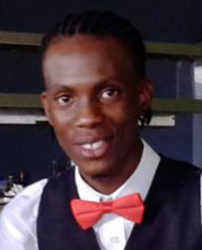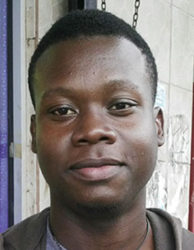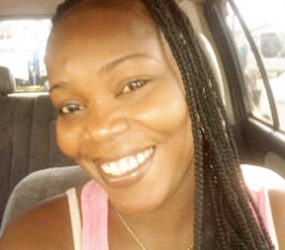Here begynneth a treatyse how þe hye Fader of Heven sendeth Dethe to somon every creature to come and gyve acounte of theyr lyves in this worlde, and is in maner of a morall playe.
(Here begins a treatise how the high Father of Heaven sends Death to summon every creature to come and give account of their lives in this world, and is in the manner of a moral play.)
Everyman, frontispiece

They offered one main play – Everyman’s End, written in 2016 for the students to perform by Subraj Singh, a current lecturer and former student of NSTAD. This was accompanied on the programme by Four Women, an adapted piece, and three short dramas – Monae Matters, In Deep, and Life, Eh created out of class exercises by the current students who performed them. There were also a cabaret-type solo by Ruqayyah Boyer and a full-length dance drama by the National Dance Company, guests on the show.

The idea behind these productions is that they are a vital part of the instruction and activities of the NSTAD which has responsibility for training in theatre on a national level. As part of their requirements for graduation, the students must show that they are capable of mounting a full production on stage good enough for public viewing. The production therefore serves as a virtual final exam. They write exam papers in a number of courses studied and in addition to those, they do practicals, with Performance 6 being their final practical examination for which they are graded.
The performances give the students an opportunity to show what they have studied and researched, and is the culmination of the various academic, theoretical and practical courses that they have completed in the school. In Semester One, the public performance was drawn mainly from the History of the Stage, but drew on techniques learnt in such other courses as Acting and Voice, and Elements of Stagecraft. Performance 5: Rituals, therefore featured quite a bit of what they researched in the origins of theatre and they performed pieces drawn from ritualistic and post-modernist theatre techniques.
By the time they came to Performance 6, they would have studied many more courses in Semester Two and drew on these in the creation of material to be put on stage. The dramatic exercises were the result of studies in the course Performance Theory, but caused the students to use what they learnt in other skills and techniques. They did Options relevant to the stage – the Production class was responsible for all aspects of management of the production, those who studied Design contributed to such areas as costuming, set, masks, and properties; it was the culmination of techniques in Acting, Dance and Music.
Performance 6 was sub-titled Retribution which pulled all the pieces together in a thematic whole, as one could trace that common thread through what was dramatically presented. Retribution was a major issue in Everyman’s End and may be found with varying degrees of recognition in the three dramatic pieces which were called ‘The Emotions’, since they were exercises in the treatment of human emotions in dramatic performance.

The main play, Everyman’s End, arose from the study of the history of drama and theatre and research into the mediaeval drama. It is a morality play, a theatrical form that developed in the Middle Ages. When theatre had its rebirth during that era, it was re-introduced by priests in the Roman Catholic Church as a means of teaching Christianity to the population. Drama flourished in the church until it outgrew those boundaries and confines, moved out into the townships and out of the control of the clergy. The performances took on many elements of popular entertainment, but never gave up the main theme of religion – particularly the fate of the human soul in a worldly environment where mankind was at the centre of contending forces of good and evil.
In the morality play, the central character had to find his way through these forces, with the Good Angel(s) trying to win his soul for God, whilst the evil angels would try to influence him away to damnation in hell. Several versions of this brand of drama developed and the strongest of them that survived was a play about a central character called “Everyman”, which also became the name of the play. The surviving script is an anonymous play, Everyman, written in the Fifteenth Century, but believed to have been put together by a series of different authors and productions of the original play long before the date of the surviving script. The original is Middle English, but the play as currently known was first published between 1510 and 1530.
There were several repeat performances of it around that time and the form of drama remained popular right up to Elizabethan times in the sixteenth century. Outstanding playwright Christopher Marlowe drew on this form for his famous tragedy Doctor Faustus.

Everyman’s End was written out of NSTAD classes by Singh for the students to perform and follows the original formula to present a drama of Everyman (Kemo Cort) having to give account of his life and be judged. The Good Angel (Tristana Roberts) contends with her adversary the Demon (Vernon Benons) for the soul of Everyman in his old age when he is summoned by Death (Colleen Humphrey). The play ends when they call upon his Good Deeds (Tomika Lewis) as the final witness to sum up his life.
The play experiments with elements of post-modernism as well as a good deal of high farce or high comedy in the flashbacks to the earlier episodes of his life. Young Everyman (Nelan Benjamin) is seen in his exploits as a youth, with his victim the Shepherdess (Tikoma Austin); as well as in his middle life (Ato Vaughn) with new victims the Countess (Twyla Sealey) and even his wife (Padmini Narine). The play draws on extensions of his mind, the influences of his Wealth (Abigail Robertson), Knowledge (Uso Telford) and Good Looks (Brian Goodman), who were also servants of the Devil.
Production of this play showed off advances in modernistic theatre in the way the play was designed and was quite a good example of the students’ demonstration of a number of advanced techniques in modern theatre. The demons – evil angels included Lakeisha Adams, Jamal Omawale, Zola Telford.
These brands of theatre were also seen in an adaptation by the students of Eve Ensler’s Vagina Monologues. This was a presentation by four women focusing a theme of domestic violence played by Boyer, Donna Sargeant, Sealey and Ackeeni Bentinck. Here they made use of dance, music and movement for impressive dramatic effect. Other students in the production included Quincy Richards (who was also Production Manager), Dolissa Sookram, Yashwantie Rampertab and Ashmini Morlyn-Shaw.

The three short dramas created around actors’ explorations of human emotions all touched in one way or another on the overall theme of retribution. They were mostly done closer to social realism than the other performed pieces and focused on melodrama, tragedy and comedy.
Both In Deep and Monae Matters were audience favourites as they appealed to popular reactions particularly in the shocking domestic revelations of In Deep and the street wise world of prostitution and sensationalism in Monae Matters. Life, Eh allowed for a commendable acting effort from Telford and good support from Robertson, but did not work as a play.
On the whole, the NSTAD students’ production was a place to go to see the kind of theatre that has been emerging recently in Guyana. It is a theatre that ventures out, extends frontiers and boundaries and shows developments on the local stage.




